Tutorial - Local Scan Mode
このチュートリアルでは、Vulsを用いてローカルホストの脆弱性をスキャンする方法を学びます。 手順は以下の通りです。
- CentOSを準備する
- Vulsをデプロイ
- 設定
- 設定ファイルと、スキャン対象サーバの設定のチェック
- スキャン
- レポート作成
- TUI(Terminal-Based User Interface)で結果を参照する
- Web UI (VulsRepo)
Step1. CentOSの準備
今回は説明のために、脆弱性を含む古いAMIを使う
EC2作成時に自動アップデートされるとVulsスキャン結果が0件になってしまうので、cloud-initに以下を指定してEC2を作成する。
Q: どうやったら重大で重要なセキュリティアップデートが初回起動時に自動でインストールされてしまうのを防げますか?
#cloud-config repo_upgrade: none
Step2. Vulsをデプロイ
There are several ways to set up Vuls.
An easy one is vulsctl/install-host. It can be tedious, but you can also do set up manually instead of vulsctl.
Step3. 設定
Create a config file(TOML format).
$ cd $HOME
$ cat config.toml
[servers]
[servers.localhost]
host = "localhost"
port = "local"
Step4. 設定ファイルと、スキャン対象サーバの設定のチェック
$ vuls configtest
Step5. スキャン
$ vuls scan
... snip ...
One Line Summary
================
localhost centos7.3.1611 31 updatable packages
Step6. レポート
View one-line summary
$ vuls report -format-one-line-text
One Line Summary
================
localhost Total: 109 (High:35 Medium:55 Low:16 ?:3) 31 updatable packages
View short summary
$ vuls report -format-list
localhost (centos7.3.1611)
==========================
Total: 109 (High:35 Medium:55 Low:16 ?:3) 31 updatable packages
CVE-2015-2806 10.0 HIGH (nvd)
Stack-based buffer overflow in asn1_der_decoding in libtasn1 before 4.4 allows
remote attackers to have unspecified impact via unknown vectors.
---
https://nvd.nist.gov/vuln/detail/CVE-2015-2806
https://access.redhat.com/security/cve/CVE-2015-2806 (RHEL-CVE)
10.0/AV:N/AC:L/Au:N/C:C/I:C/A:C (nvd)
2.6/AV:N/AC:H/Au:N/C:N/I:N/A:P (redhat)
https://nvd.nist.gov/vuln-metrics/cvss/v2-calculator?name=CVE-2015-2806
3.3/CVSS:3.0/AV:L/AC:L/PR:N/UI:R/S:U/C:N/I:N/A:L (redhat)
https://nvd.nist.gov/vuln-metrics/cvss/v3-calculator?name=CVE-2015-2806
Confidence: 100 / OvalMatch
... snip ...
View full report.
$ vuls report -format-full-text | less
localhost (centos7.3.1611)
==========================
Total: 109 (High:35 Medium:55 Low:16 ?:3) 31 updatable packages
CVE-2015-2806
----------------
Max Score 10.0 HIGH (nvd)
nvd 10.0/AV:N/AC:L/Au:N/C:C/I:C/A:C
redhat 2.6/AV:N/AC:H/Au:N/C:N/I:N/A:P
redhat 3.3/CVSS:3.0/AV:L/AC:L/PR:N/UI:R/S:U/C:N/I:N/A:L
CVSSv2 Calc https://nvd.nist.gov/vuln-metrics/cvss/v2-calculator?name=CVE-2015-2806
CVSSv3 Calc https://nvd.nist.gov/vuln-metrics/cvss/v3-calculator?name=CVE-2015-2806
Summary Stack-based buffer overflow in asn1_der_decoding in libtasn1 before 4.4 allows
remote attackers to have unspecified impact via unknown vectors.
Source https://nvd.nist.gov/vuln/detail/CVE-2015-2806
RHEL-CVE https://access.redhat.com/security/cve/CVE-2015-2806
CWE-119 (nvd) https://cwe.mitre.org/data/definitions/119.html
Package/CPE libtasn1-3.8-3.el7 -
Confidence 100 / OvalMatch
... snip ...
View Japanese
$ vuls report -format-list -lang ja | less
localhost (centos7.3.1611)
==========================
Total: 109 (High:35 Medium:55 Low:16 ?:3) 31 updatable packages
CVE-2017-12188 7.6 IMPORTANT (redhat)
Linux Kernel におけるパストラバーサルの脆弱性
Linux Kernel には、パストラバーサルの脆弱性が存在します。
---
https://jvndb.jvn.jp/ja/contents/2017/JVNDB-2017-009311.html
https://access.redhat.com/security/cve/CVE-2017-12188 (RHEL-CVE)
6.9/AV:L/AC:M/Au:N/C:C/I:C/A:C (nvd)
6.5/AV:A/AC:H/Au:S/C:C/I:C/A:C (redhat)
6.9/AV:L/AC:M/Au:N/C:C/I:C/A:C (jvn)
https://nvd.nist.gov/vuln-metrics/cvss/v2-calculator?name=CVE-2017-12188
7.6/CVSS:3.0/AV:A/AC:H/PR:H/UI:N/S:C/C:H/I:H/A:H (redhat)
https://nvd.nist.gov/vuln-metrics/cvss/v3-calculator?name=CVE-2017-12188
Confidence: 100 / OvalMatch
... snip ...
Step7. TUI
Vuls has Terminal-Based User Interface to display the scan result.
$ vuls tui

Step8. Web UI (VulsRepo)で結果を参照する

Check it out the Online Demo.
Installation refer to VulsRepo